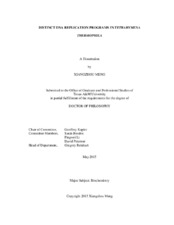| dc.description.abstract | DNA replication is a vital process to duplicate genetic material for inheritance. A conventional mitotic cell cycle is composed of G1, S, G2 and M phases, and DNA is replicated during S phase. Besides the conventional cell cycle, there are other distinct replication programs. Here in my dissertation, I used the organism Tetrahymena thermophila to study DNA replication because it employs alternative DNA replication programs, such as genome-wide endoreplication, locus-specific gene amplification and an unprecedented DNA replication program in cells that are recovered from hydroxyurea (HU) induced replication stress.
In my dissertation research, I determined that ribosomal DNA (rDNA) minichromosome amplification occurs when non-rDNA chromosomes are undergoing endoreplication during Tetrahymena development, and that both programs are shut down simultaneously. I found that rDNA amplification is then switched to endoreplication upon refeeding when the levels of the initiation proteins, the origin recognition complex (ORC) and the minichromosome maintenance protein complex (MCM2-7) are dramatically reduced. During this stage, the rDNA origin is not utilized, and a higher origin density was observed on a genome-wide scale. These data indicate that origin utilization is altered for endoreplication and suggest an ORC-independent initiation mechanism. More importantly, rDNA replication intermediates that are accumulated in both wild type endoreplication and vegetative S phase of a histone monomethyltransferase defective strain TXR1Δ share the same signature, suggesting epigenetic modifications may be involved in replication initiation and elongation during endoreplication.
As part of my dissertation research, I studied a DNA replication program that occurs after ORC and MCM proteins are degraded in hydroxyurea treated cells. I found that replication forks are arrested rather than slowed down upon HU treatment, when the protein levels of ORC and MCMs are degraded. I detected new origin firing on a genome-wide scale upon HU removal, before the protein levels of ORC and MCMs are restored. Moreover, the rDNA origin that is used for vegetative S phase is not utilized in this specialized replication program. The collective data suggest that an ORC-independent initiation is utilized.
In summary, my research has led to new discoveries of distinct DNA replication initiation and elongation mechanisms in eukaryotes. | en |


